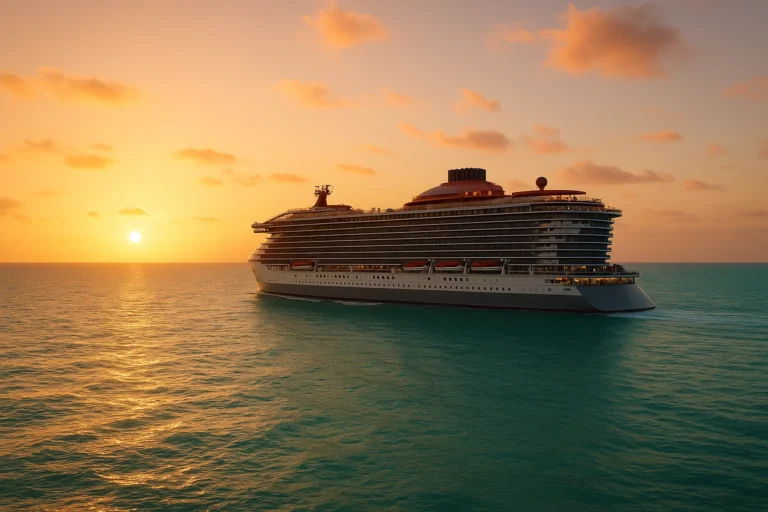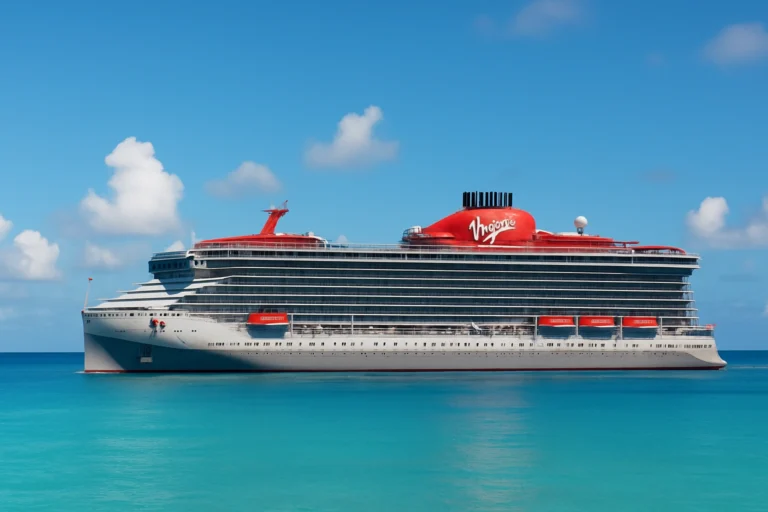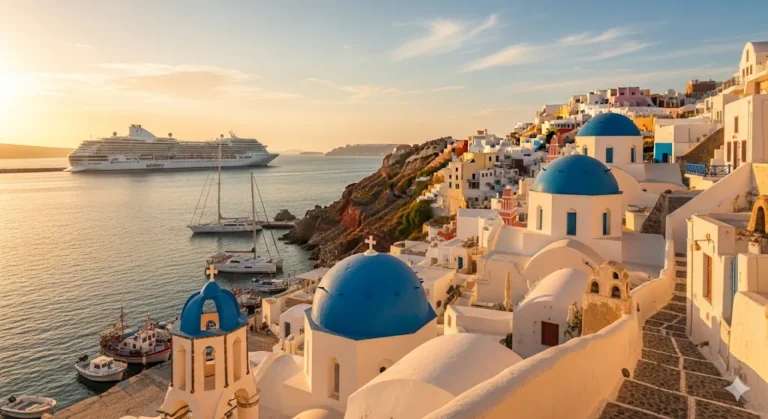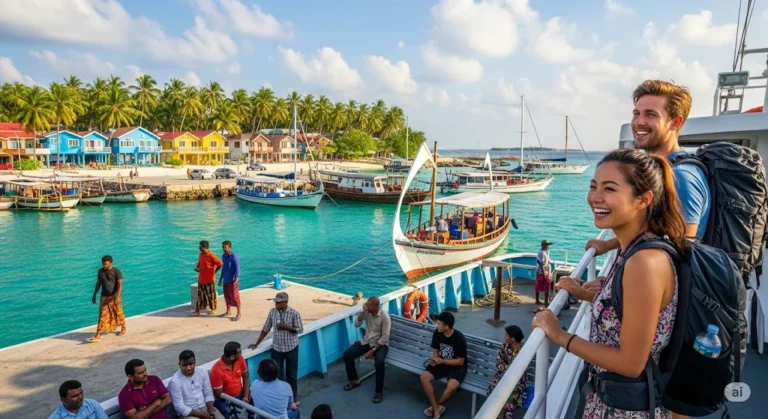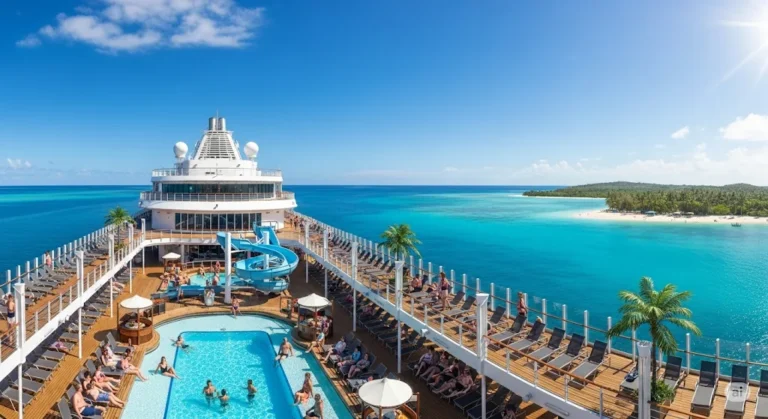A Foodie’s Guide to a Mediterranean Cruise
Discover a Paradise for Food Lovers!
A Foodie’s Guide to a Mediterranean Cruise
The Essential Foodie’s Guide for a Cruise Full of Flavors and Delights.
The Mediterranean Sea is not just a place of crystalline waters, ancient history, and idyllic landscapes; it’s also a vibrant heart of world gastronomy. For a true foodie, a Mediterranean cruise is more than just a vacation—it’s an epicurean journey, an opportunity to explore an infinite variety of flavors, textures, and culinary traditions. From the fresh fish in Italian ports to the vibrant aromas of spice markets in the East, each stop is a new promise of taste. This guide is dedicated to those who believe the best way to get to know a culture is through its food, offering tips and ideas to turn your cruise into a true feast for the senses.
Chapter 1: Savoring the Mediterranean Sea
A culinary cruise through the Mediterranean is all about variety. The best experiences combine the convenience of onboard dining with the authenticity of local food in port. Here’s how to make the most of your journey:
Exploring Local Markets: The Heartbeat of Mediterranean Cuisine
Each port offers a unique opportunity to immerse yourself in the local food scene. Forget about generic tourist restaurants and head straight for the markets!
- Naples (Italy): Dive into the famous Mercato di Porta Nolana, a sensory overload of fresh produce, street food, and seafood straight from the bay. Try a slice of authentic Neapolitan pizza or a classic sfogliatella.
- Barcelona (Spain): La Boqueria is a world-renowned market where you can wander among stalls filled with colorful fruits, exquisite Iberian ham, and fresh seafood. Don’t miss the chance to try a “tapa” at one of the small bars inside.
- Marseille (France): Explore the Vieux-Port fish market, where local fishermen sell their fresh catch every morning. You can even find the ingredients for a traditional bouillabaisse.
Pro Tip: Markets are perfect for trying new things. Don’t be afraid to ask vendors for samples of cheese, olives, or local fruits. This is a great way to discover new flavors and support local businesses.
A Deep Dive into Regional Flavors
The Mediterranean is not a single culinary entity. It’s a patchwork of diverse regions, each with its own distinct flavors, ingredients, and traditions. A well-planned cruise allows you to sample a curated selection of these unique cuisines. Let’s explore some of the most famous ones you’ll encounter:
- The Italian Coastline: The Land of Pasta and PassionItaly’s culinary identity is incredibly regional, with flavors changing from north to south. In Naples, you’ll find the home of pizza, a UNESCO-protected art form. But venture to the Amalfi Coast, and the focus shifts to fresh seafood, bright lemons, and a sweet liqueur called limoncello. In Sicily, don’t miss arancini, deep-fried rice balls filled with ragù, or the classic cannoli. Venice, in the north, offers a unique cuisine based on seafood from the lagoon and small, savory snacks called cicchetti, which are perfect with a glass of local wine. The sheer variety of pastas, risottos, and gelato from one port to the next is a culinary journey in itself.
- Greece & The Aegean: The Heart of the Mediterranean DietGreek food is a celebration of simplicity and fresh ingredients. The cornerstone is high-quality olive oil, followed by fresh vegetables, herbs, and grilled meats and fish. In ports like Athens, you can savor authentic moussaka or souvlaki. On the islands, the menu shifts to just-caught seafood, local cheeses like feta, and dishes like dolmades (stuffed vine leaves). Don’t forget to sample a glass of ouzo or tsipouro, and indulge in a phyllo pastry dessert soaked in honey, like baklava or galaktoboureko. Greek cuisine is not just food; it’s a way of life centered around sharing and community.
- Spain: The Land of Tapas and PaellaSpanish cuisine is renowned for its communal dining culture and incredible regional diversity. While in Barcelona, you must try the famous tapas, small plates of patatas bravas, chorizo, and gambas al ajillo. But in other ports, you’ll find different specialties. In Valencia, the birthplace of paella, you can enjoy a dish made with seafood or chicken. In the Basque region, you’ll find pintxos, small snacks served on bread. Spanish food is a feast for the senses, celebrated with a glass of sangria or a refreshing Cava. The vibrant atmosphere of Spanish dining perfectly complements the sunny, energetic culture.
Chapter 2: Beyond the Plate
While the food itself is the main event, the true culinary adventure is about the experience surrounding it. Engaging with the culture through food goes beyond simply eating; it’s about learning and participating.
Cooking Classes Onboard and Ashore
Why just eat the food when you can learn to make it yourself? Many cruise lines have expanded their offerings to include hands-on cooking classes that teach you how to prepare regional dishes.
- Onboard: These classes, often led by the ship’s expert chefs, teach you everything from rolling pasta to baking the perfect soufflé. It’s a fun, social activity that leaves you with a delicious new skill.
- Ashore: Look for shore excursions that include a cooking class in a local town. Imagine learning to make paella in Spain, pasta in Italy, or a Greek salad in Santorini, all from a local expert in a traditional setting.
Benefit: These experiences provide a deeper connection to the culture you are visiting and give you a culinary souvenir to take home that you can enjoy for years to come.
Fine Dining and Authentic Local Cuisine
While cruise ships are known for their spectacular buffets, make sure to explore the specialty restaurants, which often offer a more refined culinary experience. Many ships have venues dedicated to Italian, French, or Mediterranean cuisine, with menus crafted by celebrity chefs. However, the true magic happens when you venture off the ship.
- Restaurant Selection: Research restaurants in each port of call ahead of time. Look for small, family-run establishments that are popular with locals. A good sign is a simple menu that focuses on fresh, seasonal ingredients.
- Local Specialties: Don’t hesitate to ask your waiter for recommendations for local dishes. Try a traditional seafood platter in Greece, fresh-made pasta with a simple tomato sauce in Italy, or a plate of tapas in Spain. These authentic flavors are the soul of the region.
Tip: A good rule of thumb is to avoid restaurants right next to major tourist attractions. Walk a few blocks away to find hidden gems with better food and prices.
📂 Explore More in These Categories
Cruise Travel Tips – Expert Advice & Guides
Mediterranean Cruises: Best Ports, Tips & Hidden Gems (2025)
The Onboard Culinary Experience: A Chef’s Perspective
Life as a chef on a cruise ship is a fascinating and demanding job. Executive chefs oversee a massive operation, often preparing thousands of meals a day across multiple restaurants and dining venues. The logistics of sourcing, storing, and preparing fresh ingredients at sea are a marvel of modern engineering and planning. Cruise lines often forge relationships with local purveyors in key ports to ensure the freshest produce, fish, and meats are brought on board. This commitment to fresh, regional ingredients elevates the dining experience far beyond simple mass catering. From the buffet to the most exclusive fine-dining restaurant, a team of dedicated chefs works tirelessly to deliver a consistent, high-quality culinary experience that reflects the regions you are sailing through.
Wine and Cocktail Tasting: A Journey in a Glass
No culinary journey through the Mediterranean is complete without exploring the world of wine and spirits. The region is home to some of the oldest winemaking traditions on Earth. Many cruise lines offer curated wine and spirits tasting events led by onboard sommeliers and mixologists.
- Wine Tastings: These events allow you to sample local wines from the regions you visit, from the robust reds of Tuscany to the crisp whites of Santorini. A sommelier will guide you through the tasting notes, helping you understand the terroir and history behind each glass.
- Cocktail Classes: Learn to craft classic Mediterranean cocktails like the Aperol Spritz or a French 75. These interactive sessions are a fun way to socialize and learn a new skill you can show off at home.
Benefit: Pairing local wines with the regional food you’re eating in port enhances the entire culinary experience. It’s a sensory lesson in how flavor profiles complement each other, creating a truly unforgettable meal.
Chapter 3: Practical Planning for the Foodie Traveler
To ensure your culinary adventure is a success, a little planning goes a long way. This chapter provides actionable advice for booking, budgeting, and packing for your trip.
Choosing the Right Cruise Line for Foodies
Not all cruise lines are created equal when it comes to gastronomy. While most offer a variety of food, some have a special focus on dining.
- Luxury Lines (e.g., Oceania Cruises, Regent Seven Seas Cruises): These lines are often considered the gold standard for cruise cuisine. They feature world-class chefs, a high ratio of specialty restaurants, and a strong emphasis on sourcing fresh, local ingredients. Oceania, for example, is famous for its “culinary-focused” cruises with top-tier dining.
- Premium Lines (e.g., Celebrity Cruises, Princess Cruises): These lines strike a great balance between quality and value. They offer a good selection of complimentary and specialty dining options, often with celebrity chef partnerships. Celebrity, in particular, has a strong reputation for innovative and high-quality food.
- Mainstream Lines (e.g., Royal Caribbean, Norwegian Cruise Line): While these lines offer a wide array of dining choices, they are generally less focused on a singular culinary experience. They are great for a broad selection, but you may have to pay extra for the more curated dining experiences.
Tip: Check the menus and restaurant options for your specific ship and itinerary before booking. Read reviews from other food-focused travelers to get a real sense of what to expect.
Booking Culinary Shore Excursions
The best food experiences are often found on shore. To maximize your time, consider booking specialized culinary excursions.
- Food Tours: These guided tours take you through local neighborhoods and markets, allowing you to sample a variety of dishes from small, family-run eateries. They are a fantastic way to discover hidden gems you might otherwise miss.
- Cooking Classes: As mentioned before, these provide a hands-on learning experience. Look for classes that take you to a local market first to select ingredients, as this adds an extra layer of authenticity to the experience.
- Wine & Spirits Tours: Visit local vineyards or distilleries for a guided tour and tasting. This is a great way to learn about the region’s beverage traditions and the process from grape to glass.
Pro Tip: You can book these tours through your cruise line, but you can often find more intimate and unique experiences by booking with a local provider directly. Just be sure to check the timing to ensure you don’t miss the ship’s departure.
Budgeting for Your Culinary Journey
A cruise fare covers most of your food, but if you want to fully embrace the foodie lifestyle, you’ll need to budget for additional expenses.
- Specialty Dining: These restaurants are not included in your base fare and can range from $30 to $100+ per person. It’s worth planning to eat at one or two for a special occasion.
- On-Shore Meals: A single meal in a port city can range from a few dollars for a street food snack to over $50 for a multi-course dinner with wine. Budgeting for at least one meal a day in port allows you to experience the local flavor without breaking the bank.
- Souvenirs: Factor in the cost of local culinary souvenirs, such as olive oil, spices, or wine, to bring home with you.
Chapter 4: The Mediterranean Diet and Its Lifestyle
More than just a collection of dishes, the Mediterranean diet is a way of life. It’s a health-conscious approach to eating that is as delicious as it is beneficial. A cruise through the region is the perfect opportunity to see this lifestyle in action and even adopt some of its principles.
Key Ingredients and Health Benefits
The Mediterranean diet is renowned for its positive impact on health, from reducing the risk of heart disease to promoting longevity. Its power lies in a few key ingredients:
- Olive Oil: The heart of Mediterranean cooking, used for everything from frying to finishing dishes. Its high monounsaturated fat content is a cornerstone of the diet’s health benefits.
- Fresh Produce: A diet rich in fruits, vegetables, and legumes is a hallmark of the region. These foods are packed with vitamins, minerals, and antioxidants.
- Seafood: A primary source of protein, especially along the coasts. Fatty fish like sardines, mackerel, and tuna are rich in Omega-3 fatty acids, which are great for brain and heart health.
- Whole Grains and Legumes: Breads, pasta, and pulses like lentils and chickpeas are staples, providing sustained energy and fiber.
- Herbs and Spices: Flavor comes from herbs like basil, oregano, and rosemary, not from excess salt or unhealthy fats.
By focusing on these ingredients, the Mediterranean diet is a delicious path to better health, and a cruise gives you the chance to try them at their freshest.
Bringing the Flavor Home: Post-Cruise Tips
Your culinary journey doesn’t have to end when you disembark. The experience can inspire a lifelong love of Mediterranean cooking.
- Invest in a Good Cookbook: Look for cookbooks that focus on a specific region you visited, like “The Food of Italy” or “Taverna: Recipes From a Greek Kitchen.”
- Find a Local Market: Explore local farmers’ markets for fresh produce, and seek out specialty food stores for authentic olive oil, spices, and cheeses.
- Start Simple: Try recreating a simple dish you loved, like a Greek salad or a fresh pasta with a simple tomato and basil sauce. The key is to use fresh, high-quality ingredients.
People Also Ask
Answers to Common Questions
What can you do on a Mediterranean cruise?
A Mediterranean cruise offers a wide range of activities both on and off the ship. Onboard, you can enjoy pools, spas, fitness centers, evening shows, casinos, and a variety of dining options. Ashore, each port provides opportunities for sightseeing historical landmarks (e.g., the Colosseum in Rome or the Parthenon in Athens), exploring charming towns, relaxing on beautiful beaches, shopping at local markets, and, of course, indulging in local cuisine through food tours or cooking classes.
What is it like to cook on a cruise ship?
Cooking classes on a cruise ship are designed to be fun, hands-on, and accessible for all skill levels. They often take place in a dedicated, professionally equipped kitchen. An executive chef or culinary specialist guides a small group through the preparation of several dishes. These classes are typically themed, focusing on a specific cuisine (e.g., Italian pasta or Mediterranean meze). Participants work at their own stations and get to enjoy the dishes they prepare at the end of the class. It’s a social and educational experience, perfect for meeting other passengers who share your passion for food.
Does Royal Caribbean do cooking classes?
Yes, Royal Caribbean and other major cruise lines do offer cooking classes and culinary demonstrations. These are typically specialty experiences and may be available on specific ships or itineraries, such as those visiting the Mediterranean. They often come with an additional fee. Royal Caribbean has offered classes like “Chef’s Table” experiences, while other lines like Regent Seven Seas Cruises and Oceania Cruises are well-known for their extensive culinary arts programs and cooking schools at sea.
What is the average cost of a Mediterranean cruise?
The cost of a Mediterranean cruise can vary significantly based on several factors, including the cruise line, the duration of the trip, the season, and the type of cabin you book. A budget-friendly, week-long cruise in the shoulder season might start at around $600 to $900 per person. A mid-range cruise could range from $1,200 to $2,500 per person, while a luxury, all-inclusive cruise lasting 10-14 days could cost several thousand dollars or more. The average cost generally falls in the range of $1,000 to $2,000 per person for a standard week-long itinerary, not including flights or excursions.
What are the best Mediterranean cruise lines for foodies?
For food-focused travelers, cruise lines that emphasize culinary experiences, high-quality ingredients, and a variety of specialty dining options are ideal. Oceania Cruises is often considered a top choice, as their tagline is “The Finest Cuisine at Sea.” They offer extensive cooking classes and a strong focus on local sourcing. Regent Seven Seas Cruises is another luxury option known for its all-inclusive fine dining. Among premium lines, Celebrity Cruises has a strong reputation for innovative cuisine, celebrity chef partnerships, and a good selection of specialty restaurants. Viking Ocean Cruises is also a great option, as their itineraries are designed with a cultural focus, including a strong emphasis on regional cuisine and local food excursions.
Do cruise ships cater to dietary restrictions and allergies?
Yes, modern cruise ships are very well-equipped to handle a wide range of dietary restrictions and food allergies. It is highly recommended that you inform the cruise line of your specific needs at the time of booking, and then confirm them with the maître d’hôtel or a head waiter on the first day of your cruise. Most ships offer options that are gluten-free, dairy-free, vegetarian, and vegan. For more severe allergies, the culinary team will often work with you to create personalized meals to ensure your safety and comfort. It’s always best to be proactive and communicate your needs clearly to the staff.
What are some must-try local foods on a Mediterranean cruise?
The Mediterranean is a foodie’s paradise with endless options. Some must-try dishes include: Paella in Spain, especially in Valencia. Fresh seafood and octopus dishes in Greece, paired with a glass of local wine. Authentic Neapolitan pizza in Naples, Italy. The savory bouillabaisse in Marseille, France. In Croatia, don’t miss the fresh, grilled fish and local cured meats. In Turkey, try a traditional kebab or the sweet, layered pastry known as baklava. Sampling local olives, cheeses, and freshly baked bread is also a simple but essential part of the experience in any port of call.
Should I book a food tour or a cooking class?
The choice between a food tour and a cooking class depends on your preference. A food tour is perfect for those who want to sample a wide variety of foods in a short amount of time, with a guide providing cultural and historical context. It’s an excellent way to get an overview of a city’s culinary scene and discover new flavors. A cooking class is ideal if you want a more hands-on, immersive experience and are interested in learning a specific skill or recipe. It’s a deeper dive into the culture and provides a “culinary souvenir” you can use for years to come. Many travelers choose to do both on different days to get the best of both worlds.
Is the food on cruise ships all-inclusive?
The food on a cruise ship is not always fully all-inclusive. The fare typically includes dining at the main dining room, the buffet, and a few casual cafes. These options provide plenty of variety and food to eat for your entire cruise. However, most modern cruise lines also offer specialty restaurants, which come with an additional charge. These are often themed (e.g., steakhouse, Italian trattoria, sushi bar) and provide a more intimate, gourmet dining experience. Beverages, especially alcoholic drinks, are usually not included in the base fare and are available for purchase or as part of a beverage package.
What is the Mediterranean diet?
The Mediterranean diet is a way of eating based on the traditional foods and drinks of countries bordering the Mediterranean Sea. It is a highly-regarded and healthy eating plan, not a strict diet. Its key components include a high intake of fresh vegetables, fruits, whole grains, beans, and nuts. Olive oil is the primary source of fat. The diet includes moderate amounts of fish and poultry and a low intake of red meat and sweets. A glass of red wine with meals is also a traditional component. This eating pattern is associated with a lower risk of heart disease, longer life expectancy, and better overall well-being.
Can I bring local food back on the ship?
Bringing food back on a cruise ship is generally a “no” for prepared or perishable items due to health and safety regulations. This is to prevent the spread of foodborne illnesses. However, many cruise lines do allow you to bring non-perishable, packaged items back on board. This includes things like local spices, olive oil, dried herbs, or packaged treats. It is always best to check with the specific cruise line’s policy or with the onboard security staff if you are unsure about a particular item. Bringing back a taste of the Mediterranean in a sealed jar of tapenade or a bottle of local olive oil is a wonderful souvenir of your culinary journey.
🍽️ Your Culinary Journey Awaits!
A cruise is the perfect vehicle for a culinary adventure, connecting you to diverse cultures through the universal language of food. From savoring a freshly baked baguette in France to learning the secrets of pasta-making in Italy, every moment is an opportunity for a new culinary discovery. So, pack your appetite and get ready to sail on the most delicious vacation of your life!
Tell us about your favorite Mediterranean food experience!
What’s the one dish or culinary experience from a Mediterranean port that you can’t stop thinking about? Share your stories and recommendations in the comments below!




